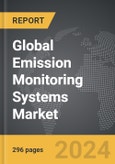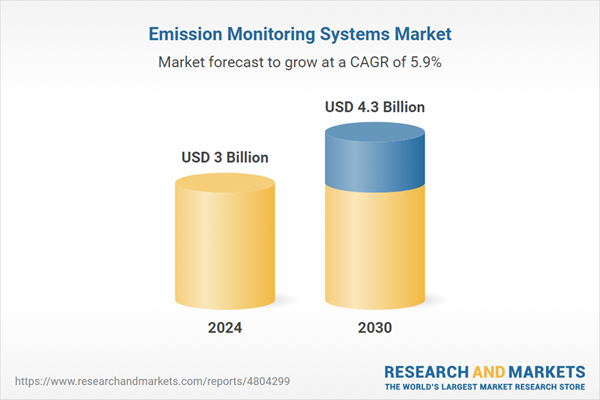The global market for Emission Monitoring Systems was valued at US$3.0 Billion in 2024 and is projected to reach US$4.3 Billion by 2030, growing at a CAGR of 5.9% from 2024 to 2030. This comprehensive report provides an in-depth analysis of market trends, drivers, and forecasts, helping you make informed business decisions.
Global Emission Monitoring Systems Market - Key Trends and Drivers Summarized
How Are Emission Monitoring Systems Revolutionizing Environmental Compliance and Industrial Operations?
Emission monitoring systems (EMS) are revolutionizing environmental compliance and industrial operations by providing accurate, real-time data on pollutant emissions, enabling industries to meet stringent environmental regulations and optimize their processes for sustainability. These systems are crucial for monitoring and controlling the emissions of harmful gases, particulates, and other pollutants from industrial facilities, such as power plants, refineries, and manufacturing sites. By continuously measuring the types and amounts of pollutants being emitted, EMS helps companies ensure that they remain within legal limits, thereby avoiding hefty fines, legal actions, and potential shutdowns. Moreover, the detailed insights provided by these systems allow operators to fine-tune their processes, reduce waste, and improve efficiency, leading to both environmental and economic benefits. As governments worldwide enforce tighter emissions standards in response to growing concerns about air quality and climate change, EMS has become an indispensable tool for companies committed to responsible environmental management and operational excellence.What Innovations Are Enhancing the Functionality of Emission Monitoring Systems?
Innovations in emission monitoring systems are enhancing their functionality through advancements in sensor technology, data analytics, and integration with industrial automation systems. One of the most significant developments is the use of advanced sensor technologies that offer greater sensitivity and accuracy, allowing for the detection of even trace amounts of pollutants. These sensors can measure a wide range of gases, particulates, and other emissions with high precision, providing reliable data that can be used to meet regulatory requirements and improve environmental performance. Another key innovation is the integration of EMS with advanced data analytics platforms, which can process large volumes of emissions data in real-time, providing actionable insights and enabling predictive maintenance. This capability helps operators anticipate and prevent potential emissions exceedances before they occur, improving compliance and reducing the risk of costly penalties. Additionally, the trend toward digitalization and Industry 4.0 is driving the integration of EMS with industrial automation systems, allowing for more seamless control of emissions through automated adjustments to processes based on real-time monitoring data. The use of cloud-based systems for remote monitoring and management is also expanding, enabling companies to oversee emissions across multiple sites from a central location. These innovations are making emission monitoring systems more effective, user-friendly, and integral to modern industrial operations.How Do Emission Monitoring Systems Impact Environmental Compliance and Operational Efficiency?
Emission monitoring systems have a profound impact on environmental compliance and operational efficiency by ensuring that industries can meet environmental regulations while optimizing their processes. The continuous data provided by EMS enables companies to monitor their emissions in real-time, ensuring that they remain within the limits set by local, national, and international regulatory bodies. This compliance is essential not only for avoiding fines and legal actions but also for maintaining the social license to operate in communities concerned about air quality and environmental health. Beyond compliance, the insights generated by EMS can lead to significant operational improvements. By identifying inefficiencies in production processes that result in higher emissions, companies can implement targeted improvements that reduce waste, lower energy consumption, and enhance overall process efficiency. This dual benefit of regulatory compliance and operational optimization makes EMS a critical investment for any company looking to reduce its environmental impact and improve its bottom line. Furthermore, the transparency provided by EMS data supports corporate sustainability reporting, allowing companies to demonstrate their commitment to environmental stewardship to stakeholders and the public.What Trends Are Driving Growth in the Emission Monitoring Systems Market?
Several trends are driving growth in the emission monitoring systems market, including the tightening of environmental regulations, the increasing focus on sustainability and corporate social responsibility, and the advancement of smart technologies. As governments around the world introduce stricter emissions standards to combat climate change and protect air quality, industries are compelled to adopt more sophisticated monitoring solutions to ensure compliance. This regulatory pressure is a significant driver of EMS market growth, particularly in sectors such as energy, chemicals, and manufacturing, where emissions are closely scrutinized. Additionally, the growing emphasis on sustainability and corporate social responsibility is encouraging companies to proactively manage their environmental impact, with EMS playing a crucial role in these efforts. Companies are increasingly expected to not only comply with regulations but also to go beyond compliance by minimizing their environmental footprint and transparently reporting their emissions. The rise of smart technologies, including the Internet of Things (IoT) and big data analytics, is further boosting the EMS market by enabling more accurate, real-time monitoring and more sophisticated data analysis. These technologies allow for the integration of EMS with broader industrial automation systems, providing a more comprehensive approach to emissions management. The trend toward digital transformation in industrial operations is also contributing to the adoption of cloud-based EMS solutions, which offer enhanced scalability, flexibility, and remote monitoring capabilities. These trends underscore the critical role of emission monitoring systems in helping industries navigate the increasingly complex landscape of environmental regulation and sustainability.Report Scope
The report analyzes the Emission Monitoring Systems market, presented in terms of market value (US$ Thousand). The analysis covers the key segments and geographic regions outlined below.Segments
System Type (CEMS, PEMS); Offering (Hardware, Software, Services); End-Use (Power Plants & Combustion, Oil & Gas, Chemicals, Petrochemicals, Refineries & Fertilizers, Building Materials, Pulp & Paper, Other End-Uses).Geographic Regions/Countries
World; United States; Canada; Japan; China; Europe (France; Germany; Italy; United Kingdom; Spain; Russia; and Rest of Europe); Asia-Pacific (Australia; India; South Korea; and Rest of Asia-Pacific); Latin America (Argentina; Brazil; Mexico; and Rest of Latin America); Middle East (Iran; Israel; Saudi Arabia; United Arab Emirates; and Rest of Middle East); and Africa.Key Insights:
- Market Growth: Understand the significant growth trajectory of the CEMS segment, which is expected to reach US$3.3 Billion by 2030 with a CAGR of a 5.3%. The PEMS segment is also set to grow at 7.8% CAGR over the analysis period.
- Regional Analysis: Gain insights into the U.S. market, valued at $810.8 Million in 2024, and China, forecasted to grow at an impressive 9.5% CAGR to reach $952.7 Million by 2030. Discover growth trends in other key regions, including Japan, Canada, Germany, and the Asia-Pacific.
Report Features:
- Comprehensive Market Data: Independent analysis of annual sales and market forecasts in US$ Million from 2024 to 2030.
- In-Depth Regional Analysis: Detailed insights into key markets, including the U.S., China, Japan, Canada, Europe, Asia-Pacific, Latin America, Middle East, and Africa.
- Company Profiles: Coverage of major players such as AMETEK, Inc., Carbon Trust, CCS TLM Ltd., CEM Service Group, CEMTEK KVB-Enertec and more.
- Complimentary Updates: Receive free report updates for one year to keep you informed of the latest market developments.
Why You Should Buy This Report:
- Detailed Market Analysis: Access a thorough analysis of the Global Emission Monitoring Systems Market, covering all major geographic regions and market segments.
- Competitive Insights: Get an overview of the competitive landscape, including the market presence of major players across different geographies.
- Future Trends and Drivers: Understand the key trends and drivers shaping the future of the Global Emission Monitoring Systems Market.
- Actionable Insights: Benefit from actionable insights that can help you identify new revenue opportunities and make strategic business decisions.
Key Questions Answered:
- How is the Global Emission Monitoring Systems Market expected to evolve by 2030?
- What are the main drivers and restraints affecting the market?
- Which market segments will grow the most over the forecast period?
- How will market shares for different regions and segments change by 2030?
- Who are the leading players in the market, and what are their prospects?
Some of the 46 major companies featured in this Emission Monitoring Systems market report include:
- AMETEK, Inc.
- Carbon Trust
- CCS TLM Ltd.
- CEM Service Group
- CEMTEK KVB-Enertec
- Chemtrols Industries Pvt. Ltd.
- Clean Air Engineering
- CMC Solutions LLC
- CYBERHAWK Innovations Ltd.
- Ecotech Pty., Ltd.
Table of Contents
I. METHODOLOGYII. EXECUTIVE SUMMARY2. FOCUS ON SELECT PLAYERSIII. MARKET ANALYSISCANADAITALYSPAINRUSSIAREST OF EUROPESOUTH KOREAREST OF ASIA-PACIFICARGENTINABRAZILMEXICOREST OF LATIN AMERICAIRANISRAELSAUDI ARABIAUNITED ARAB EMIRATESREST OF MIDDLE EASTIV. COMPETITION
1. MARKET OVERVIEW
3. MARKET TRENDS & DRIVERS
4. GLOBAL MARKET PERSPECTIVE
UNITED STATES
JAPAN
CHINA
EUROPE
FRANCE
GERMANY
UNITED KINGDOM
ASIA-PACIFIC
AUSTRALIA
INDIA
LATIN AMERICA
MIDDLE EAST
AFRICA
Companies Mentioned (Partial List)
A selection of companies mentioned in this report includes, but is not limited to:
- AMETEK, Inc.
- Carbon Trust
- CCS TLM Ltd.
- CEM Service Group
- CEMTEK KVB-Enertec
- Chemtrols Industries Pvt. Ltd.
- Clean Air Engineering
- CMC Solutions LLC
- CYBERHAWK Innovations Ltd.
- Ecotech Pty., Ltd.
Table Information
| Report Attribute | Details |
|---|---|
| No. of Pages | 296 |
| Published | April 2025 |
| Forecast Period | 2024 - 2030 |
| Estimated Market Value ( USD | $ 3 Billion |
| Forecasted Market Value ( USD | $ 4.3 Billion |
| Compound Annual Growth Rate | 5.9% |
| Regions Covered | Global |









